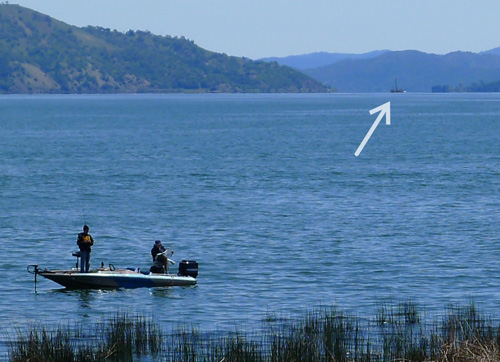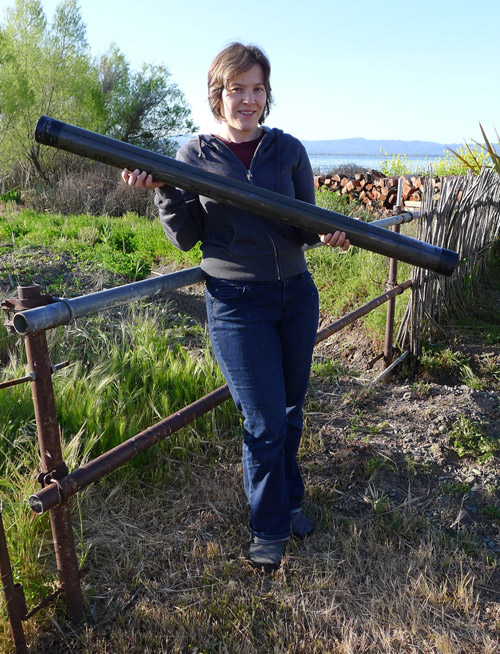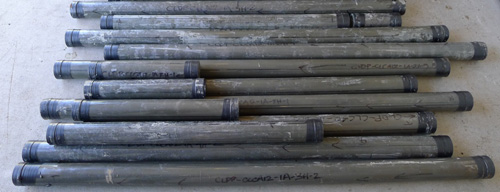UCMP’s Cindy Looy is leading a project to collect 130,000 years worth of sediment data from Clear Lake in order to better understand how life has adapted to climate change. Along the way, members of her team will report back to us with all the progress and drama from the field. Here’s our first set of dispatches.

From Ivo Duijnstee:
Thu, April 26
First mud
It has begun. Except for some minor delays, the Clear Lake drilling expedition had a relatively smooth start. When our seven-headed UC Berkeley team arrived on site in Lakeport California, six members of the not-for-profit drilling company DOSECC had already assembled the large drilling barge to the point that it was almost good to go. Not much later, three sediment core curators of the National Lacustrine Core Facility (LacCore) arrived; completing the drill team in charge of the first days of this enterprise.
Fri, April 27
Today, a boat pushed the barge to its first drilling position in the southeastern part of the northern branch of the lake. This is in a part of the lake with a thick continuous sediment package. The deeper layers date back at least to the warm part of the previous interglacial (~130,000 years ago), a period we are very much interested in, as it may provide an analog for the current climate change in California.
Sat, April 28
From our Rocky Point base camp on the other side of the water, we can barely make out the barge’s position, as the sizeable drilling barge is reduced to a mere speck on the horizon. The inconspicuousness changes dramatically when night falls and the needle in the haystack turns into a beacon of light, as soon as the flood lights on the barge are switched on.
Tonight, the night crew (on the barge everyone works in two 12-hour shifts) made their way to the barge in the former county fire boat. This boat was made available for the crews’ semidiurnal commute by our collaborators of the Lake County Water Resources Department. Around 11PM, word reached base camp that the DOSECC drillers hoisted the first sediment core up on deck.

Sun, April 29
This morning the night crew brought the uppermost 28 meter (93 ft) of sediment cores ashore, so the Holocene is taken care of. Let’s dig deeper into the Pleistocene!


So far, things are going smoothly on the drill platform. The day crew is off to their 12 hour shift, and the night crew is heading to bed. At the house in Rocky Point — our base camp — we are starting our pile of sediment-filled transparent tubes in the garage.
Mon, April 30
It’s media day!
Almost all day, camera crews, radio journalists, newspaper photographers and reporters were buzzing around, interviewing UCB/UCMP’s Cindy Looy and Liam Reidy, DOSECC Director of Operations Chris Delahunty and LacCore scientist Ryan O’Grady as they made visits to our floating drill site. We’ve had so much attention already, and the UCB press release is yet to come!

The timing of the media is perfect: just like the weather, everyone in the team is in a sunny mood since the team has reached a greater depth than the USGS did at the same location during its 1973 Clear Lake drilling program. That means that the teams first target (115 m, or 377 ft) has been reached, and there is more to come.
Gravel.
At about 140 m (460 ft) into the sediment, it’s over with the monotonously greenish grey playdough that has filled the plastic core linings so far. In the dark, the night crew has struck gravel, making it impossible to get anything out of the lake bed. Fortunately, the drillers have some tricks up their coverall sleeves. For now they are mixing a special kind of mud that the day shift will use to get through the gravel layer. They will pump the muddy mixture into the borehole so that the gaps between the chunks of gravel will be filled with sticky goo; enabling the drillers to get the loose gravel out.
Tue, May 1
Alas, despite the fact the DOSECC team successfully crossed the gravel layer, things are not going well. Beyond the gravel layer there is sand and more gravel. Now things are going this slow, we decide that it is better to stop drilling at this site, and get started on a second hole nearby. As the two drillers prepare the drilling equipment for the move to the next hole, the scientific part of the night shift gets to spend an unexpected night in the house, where it is warm and couches are comfy… perhaps a bit to comfy when you are trying to stick to the nocturnal routine of the graveyard shift…

Wed, May 2
*S* hifts are 12 hours long and days start incredibly early
*C* ores are covered in mud and so are we
*I* ncessant noise of the generators, shrouding the barge in heavy diesel fumes
*E* very day starts at 5.45am
*N* o matter what happens, the entire crew is always in great spirits
*C* lear Lake is a neat location and the weather is close to perfect
*E* asily one of the coolest projects I have ever been part of!
See more text, audio, and video coverage of the Clear Lake drilling project here.